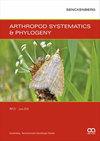对Turanium Baeckmann属的首次分子认识,1922(鞘翅目:天牛科:天牛科),并描述了一种来自中亚的新种
IF 1.8
2区 农林科学
Q2 ENTOMOLOGY
引用次数: 4
摘要
本文首次揭示了1922年中亚Turanium Baeckmann属的系统发育。本文采用综合分类学方法,发现并描述了吉尔吉斯斯坦一新种- Turanium losi Karpiński, Plewa & Hilszczański sp. 11 .。本文介绍了其与Turanium pilosum (Reitter, 1891)的区别特征,并讨论了它们的生态关系。利用扫描电镜对主要性状进行了研究,其中包括雄性终端。介绍了这两个物种的高质量栖息地照片,并绘制了它们的地理分布图。而新种表现出稳定的形态特征,使其能够从毛囊中分化出来,两者的COI遗传距离接近。3%,不同的物种划分方法给出了不一致的结果。尽管新物种长期未被识别,但这些陶粒虫似乎在该地区很常见,而且由于它们明显是高度多食性的,它们都可以被认为是潜在的入侵物种。也有文献记载,它们在吉尔吉斯斯坦同样发生。COI序列的贝叶斯分析和最大似然分析均证实了Turanium属的单系性,得到了强有力的支持(分别为pp1和bs90)。此外,最近发现的Callidiini部落的多聚性得到了我们的分析的支持,从而提出了关于建立一个新部落Ropalopini的讨论。本研究进一步证实了DNA条形码作为一种检测新物种的工具的有效性,并提供了一些在分子研究方面几乎完全未知的中亚陶粒的第一批序列。本文章由计算机程序翻译,如有差异,请以英文原文为准。
The first molecular insight into the genus Turanium Baeckmann, 1922 (Coleoptera: Cerambycidae: Callidiini) with a description of a new species from Middle Asia
This paper sheds the first light on the phylogeny of the Central Asian genus Turanium Baeckmann, 1922. By applying an integrative taxonomy approach, we revealed and described a new species from Kyrgyzstan—Turanium losi Karpiński, Plewa & Hilszczański sp. nov. Distinguishing characters from closely related Turanium pilosum (Reitter, 1891) are presented and their ecological associations are discussed. The key characters, including the male terminalia, were examined by means of scanning electron microscopy. High-quality stacked photographs of the habitus of the specimens are presented for both species and their geographical distributions are mapped. While the new species shows stable morphological characters that allow its differentiation from T. pilosum and the COI genetic distance between them is approx. 3%, the different species delimitation methods gave discordant results. Although the new species remained unrecognized for so long, it seems that these cerambycids are common in the region and both can be considered potentially invasive as they are apparently highly polyphagous. It has also been documented that they occur sympatrically in Kyrgyzstan. Both the Bayesian and maximum likelihood analyses of COI sequences confirmed the monophyly of the genus Turanium with strong support (PP 1 and BS 90, respectively). Moreover, the recently revealed polyphyly of the tribe Callidiini was supported by our analyses and, consequently, the discussion on the establishment of a new tribe Ropalopini is raised. This study further corroborates the effectiveness of DNA barcoding as a tool in detecting new species and provides some of the first sequences for Central Asian cerambycids, which remain almost completely unknown in terms of molecular studies.
求助全文
通过发布文献求助,成功后即可免费获取论文全文。
去求助
来源期刊

Arthropod Systematics & Phylogeny
Agricultural and Biological Sciences-Insect Science
CiteScore
2.50
自引率
5.60%
发文量
26
审稿时长
12 weeks
期刊介绍:
Arthropod Systematics & Phylogeny releases three times per year. Research fields covered are the taxonomy, morphology/anatomy, phylogeny (molecular or morphology-based), historical biogeography and palaeontology of arthropod taxa.
Arthropod Systematics & Phylogeny is the successor of Entomologische Abhandlungen, formerly published by the Museum of Zoology Dresden, Germany.
 求助内容:
求助内容: 应助结果提醒方式:
应助结果提醒方式:


